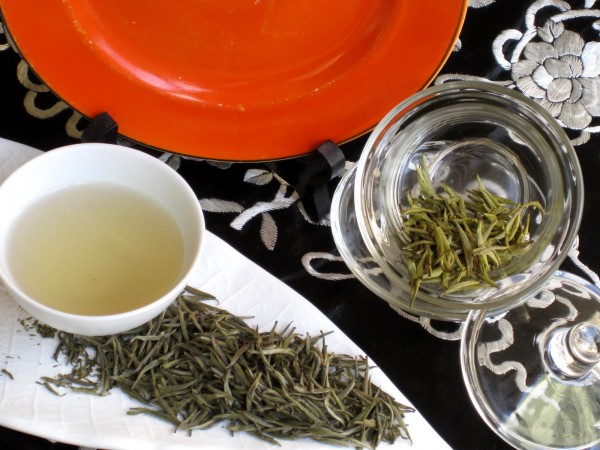
Junshan Yin Zhen (君山銀針) or Silver Needle Yellow tea, holds a place of honour in the realm of the Chinese tea world. The most famous Yellow tea in China, it grows exclusively on Junshan island, located in Dongting Lake, northern Hunan province. It is very rare, which reinforces the notion that the list was compiled for the most famous teas, not necessarily the most popular teas. I have listed it as #8 according to my distilled version of many lists, all different from one another, but I’ve seen it listed as #10, #6 and even #2. Regardless, there is no question that it makes the list for its rarity and unique processing. It was long valued as a “Tribute Tea” reserved for the Emperor or visiting dignitaries as far back as the Song dynasty (960-1279). In some cases it was presented in lieu of taxes. It was reported to be the favourite tea of Chairman Mao Zedong who grew up in Hunan province.
Terroir: “A sumptuous green conch in a silvery plate”

Junshan Island is located in the southern section of subtropical Dongting Lake in Hunan Province. The largest of the lake’s islands, it measures only 1 square km. Tang dynasty (618-907AD) poet Liu Yuxi described the island as ‘a sumptuous green conch in a silvery plate’. In researching the terroir of this tea I discovered that the lake experiences fluctuations in its water level largely due to the fact that 5 rivers empty into it, the most famous being the Yangtze. As recently as May of 2011, the lake was reporting very low water levels due to severe drought in the Yangtze River valley. Some Chinese newspapers showed small fishing boats stranded on the parched and cracked floor of the lake. The lake and some of its surrounding land also acts as a flood basin for the rivers, so it is accustomed to extremes. The flooding provides the lake with silt-based soil, rich in minerals and ideal for tea growing. Predictions from Hunan Provincial Water Resources Bureau are pessimistic, forecasting that the lake will continue to shrink in size. The island has so far been protected from drought and flooding because of its topography, however if the lake level continues to shrink, Junshan Island may in the near future, become a peninsula! Its 72 “peaks” rise only 55 metres above sea level and even though Junshan is small, it boasts so many attractions that a visitor would be expected to spend most of a day exploring. Watch this amusing video of the Finnish duo Riku & Tunna as they try to score some JSYZ in their Madventures series.
The Legends: Concubines and Lake Dragons
The requisite legends that surround most Chinese famous teas play a peripheral role here, but they still provide a mist of fantasy that brings attention to the island. Junshan Island was originally named ‘Dongting Hill’, meaning ‘cave of immortals’. There are several other ancient legends associated with Junshan Island endowing it with fame and honour.
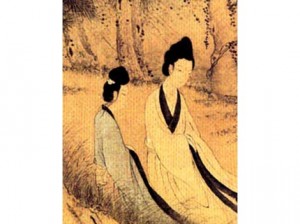
One legend tells of a visit to Dongting Lake 4,000 years ago by Emperor Shun-Ehuang while he was touring South China. When he did not return home, his two concubines E Huang and Nü Ying, also called Xiang Fei and Xiang Jun, went to search for their husband. When they got to Dongting Island, they learned that he was dead. They wept so sadly that the bamboos on which their tears dropped changed into mottled bamboos, which still exist on the island. Some versions of this legend say that they drowned themselves in the lake and were then buried on the hill and memorialized in the 2 Concubine’s Tomb. After this the mountain was renamed Junshan.
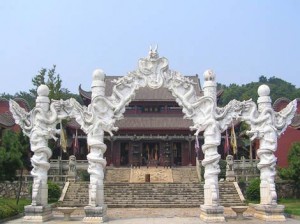
As if these dramatic legends weren’t enough to bring the island fame, Junshan Island also became known as the “Love Island” because of a myth associated with a dragon king’s daughter. Tang Dynasty writer Li Chaowei wrote of Liu Yi, a Tang Dynasty intellectual who was returning home after failing an Imperial examination. He met a pretty girl who was the daughter of the Dongting Lake Dragon. Their love was thwarted as the Dragon father refused to accept Liu Yi as a suitor. The two lovers had to mysteriously communicate with each other through a well. The well exists on the island today and is said to be an excellent source of water for making Silver Needle Yellow tea. Another version of the legend is exquisitely told here.
Tea Production
A very small quantity of Junshan Yin Zhen Yellow tea is produced each year, which explains why it is so costly – as much as $50 for 50 grams or approx. $500/lb. It is becoming increasingly difficult to find an authentic Junshan Yin Zhen Yellow tea in today’s market. Some producers skip a few of the time consuming steps in preparation of the tea and use methods that would more accurately characterize it as a green tea. Some reviewers feel that it’s subtle taste does not justify its high price. The writers of The Tea Drinker’s Handbook have this to say, “in our opinion, Jun Shan Yin Zhen is an overrated tea. Although its delicacy is impressive and, when it happens, the dance of the buds is enchanting, from a tasting point of view its high price is not justified.”
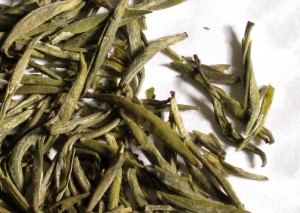
The delicate buds of Junshan Silver Needle Yellow are picked pre Qing Ming festival in late March and early April. Qing Ming festival was recently reinstated by the modern Chinese government as a way to preserve ancient values and moderate the western influences on the younger generation. It is both a festival to celebrate the arrival of spring – it translates as “Clear Bright” – and a traditional day to honour the dead by visiting the gravesites with both brooms to sweep and picnics for fun.
Junshan Silver Needle Yellow tea is processed similarly to green tea, but after the first firing it undergoes steaming followed by a prolonged “resting” wrapped in cloth or paper. This stage called men huang may last a day or two before the final firing. The moist pause allows the leaves to breathe back their own aromas and prevents the astringency associated with some green teas. It also gives the leaves a very slight yellow cast. The initial firing halts most of the oxidation, but similar to white tea it is very slightly oxidized.
Preparation:
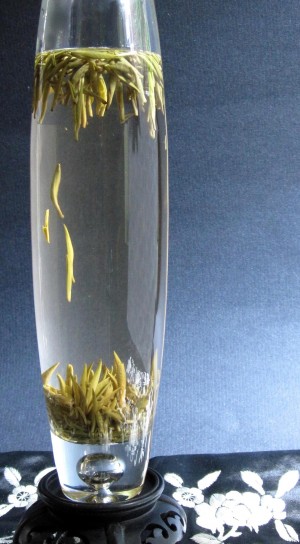
Early this year I purchased Junshan Yin Zhen, Silver Needle Yellow 2010, from Seven Cups. a trusted online retailer. They source their teas directly from the growers and occasionally feature profiles of those farmers on their website. The Junshan Yin Zhen Yellow buds shown dry, above, were covered in a fine downy hair, hence their name Yin Zhen or Silver Needle. The leaf colour was a dull light green tinged with a warm brown.
- I measured 1.7g of dry leaf for my small glass gaiwan
- Because the leaf is very mildly oxidized, I heated the filtered water to 80°C
- The leaves infused for 1¾ minutes
The liquor is a very pale yellow and the wet leaves look like tiny snow peas. The taste was indeed subtle, but round and a little more vegetal than sweet with no astringency. I wouldn’t recommend any food pairing with this tea. It may have benefited from the use of a good quality spring water rather than the filtered water that I used. The second infusion (2¼ mins) in the gaiwan presented a taste similar to the first, but with every character more pronounced. If I wanted to impress, I’d only serve infusion #2. It can be infused a third time, but its flavour starts to diminish at this point.
I was determined to see the leaves “dance” – one of the more capricious characteristics of Junshan Yin Zhen, Silver Needle Yellow. Once the buds have absorbed the water they move to the bottom of the vessel and then for some unexplained reason they will rise to the surface. This display continues for quite a few hours, but I found it only worked for me after the second infusion. I used a long narrow glass vase to get the best view. I thought I was sacrificing these infusions of tea for the photograph, but I was pleasantly surprised to find that the tea tasted delicious after many minutes at a cooler temperature when I poured out the vase. Junshan Yin Zhen, Silver Needle Yellow tea is worth experiencing. It’s enough to study the leaves and drink the liquor, but to bring enhanced value to the tea, meditate on its history and the legends that surround it.



